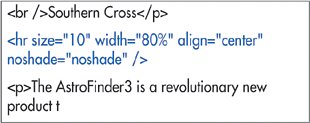Adding Horizontal Rules
| One graphic element that is completely supported by the majority of the browsers is the horizontal rule. There are several attributes you can use to jazz up horizontal rules, although they've all been deprecated in favor of styles. To insert a horizontal rule:
Figure 5.38. The hr attributes are deprecated but well supported. Figure 5.39. You can make horizontal rules thicker and narrower.
|
EAN: 2147483647
Pages: 340




 Tips
Tips